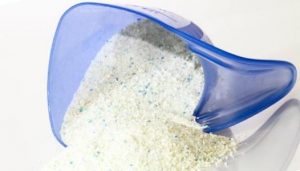Phosphoric Acid and Detergents
Phosphoric acid plays the important role in detergents production.
Detergent industry has been using big quantity of Sodium Tripolyphosphate, which is the important builder, in conjunction with surfactants in detergents, and let sufactrants perform efficiently in all washing conditions. The globe output of Sodium tripolyphosphate was around 1 million tons in 2016.
Phosphoric acid is main raw material of producing sodium tripolyphosphate:
- Phosphric acid: H3PO4
- Caustic Soda:NaOH
- Sodium Tripolyphosphate: Na5O10P3
H3PO4+NaOH ➯ Polymerization Reaction ➯ Na5O10P3
Panchem has provided phosphric acid for manufacturers of Sodium Tripolyphosphate more than twenty years.
How to produce Sodium Tripolyphosphate from phosphoric acid?
Sodium tripolyphosphate is formed by neutralizing phosphoric acid with soda ash to form sodium orthophosphate, and then condensing it. The process of preparing sodium tripolyphosphate from orthophosphate is relatively simple, the process is short, and the control and operation are convenient.
There are two main methods:
1. Spray drying-converter polycondensation two-stage method:
The spray dryer is a cylinder, and the upper part is connected with a horizontal burner with a gas nozzle. The gas with a temperature of 400-500°C is passed through the burner into the upper part of the spray drying tower, and at the same time, a high-pressure (4.2MPa) pump is used to spray the orthophosphate solution. Dry products with a water content of less than 5% are continuously taken out from the lower part of the dryer.
The orthophosphate mixture is dehydrated and polycondensed in a rotary furnace to form sodium tripolyphosphate. The feature of this method is that the product does not need to be crushed, the spray dryer has high drying efficiency, the drying material is very uniform, and no delamination phenomenon occurs. The disadvantage is that the drying and polycondensation are carried out in two stages, and the dust loss is large during direct heating and dehydration.
2. Dry-dehydration one-stage method:
The slurry is sprayed into the rotary furnace, and the nozzle is used to send hot air or burning petroleum to heat. The annular baffle divides the furnace into a flame section and a heating section. In the heating section, the material is finally dehydrated and polycondensed to be converted into sodium tripolyphosphate.
The cooling cylinder is connected with the rotary furnace. The granular products from the cooling cylinder are ground in the grinder, and a small amount of powder from the furnace is recovered in the cyclone separator. This method combines drying, dewatering and cooling in one unit of equipment, greatly simplifying the process, high heat utilization, and reducing capital investment and improving working conditions.

